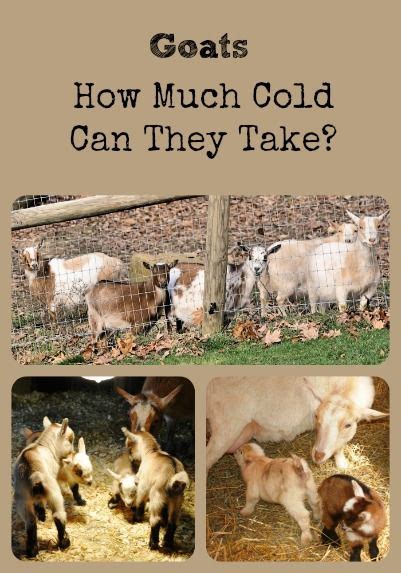How Cold Can Baby Goats Tolerate
Ronan Farrow
Apr 03, 2025 · 3 min read

Table of Contents
How Cold Can Baby Goats Tolerate? A Guide for New Goat Owners
Raising baby goats, or kids, can be a rewarding experience. However, it’s crucial to understand their vulnerability to cold temperatures. Knowing how cold baby goats can tolerate is essential for their health and survival, especially during the colder months. This comprehensive guide will explore the cold tolerance of baby goats, offering practical advice to keep them warm and healthy.
Understanding a Kid Goat's Cold Tolerance
Baby goats, unlike adult goats, have a limited ability to regulate their body temperature. Their small size and underdeveloped thermoregulatory systems make them highly susceptible to hypothermia. Hypothermia, a dangerously low body temperature, can quickly lead to serious health issues and even death if not addressed promptly.
Factors Affecting Cold Tolerance
Several factors influence how well a baby goat can withstand cold weather:
- Age: Newborn kids are the most vulnerable. Their bodies haven't fully developed the ability to generate and retain heat. As they grow older, their tolerance to cold improves.
- Breed: Certain breeds of goats are more cold-hardy than others. Those with thicker coats, like the Nigerian Dwarf, generally fare better in colder climates. However, even hardy breeds need protection from extreme cold.
- Health: A healthy kid will have a better chance of surviving cold temperatures compared to a sick or weak one. Illness can significantly impair their ability to regulate body temperature.
- Overall Condition: Well-nourished kids with access to sufficient food and water are better equipped to withstand cold than those that are malnourished or dehydrated.
- Environment: Exposure to wind, rain, and snow drastically reduces a kid's ability to stay warm. Shelter from the elements is crucial.
Critical Temperatures for Baby Goats
There's no single magic number to define the exact temperature at which a baby goat will suffer from cold stress. However, temperatures consistently below 45°F (7°C) are generally considered risky for young goats. At temperatures below 32°F (0°C), hypothermia becomes a serious concern, even with adequate shelter.
Protecting Your Baby Goats From the Cold
Providing adequate warmth is crucial for raising healthy baby goats. Here's how you can protect them from the cold:
1. Provide Adequate Shelter
Robust shelter is paramount. It should be well-insulated, windproof, and dry. A three-sided shelter is ideal, allowing for natural ventilation while protecting them from the elements. The shelter should be large enough to accommodate all the kids comfortably without overcrowding.
2. Utilize Bedding
Deep bedding made from straw, hay, or wood shavings is essential. It helps insulate the kids and keep them warm and dry. Ensure the bedding is regularly cleaned and replenished to maintain dryness and hygiene.
3. Monitor Body Temperature
Regularly check your baby goats' body temperature, particularly during cold snaps. A rectal thermometer is the most accurate method. Contact your veterinarian immediately if you suspect hypothermia.
4. Supplement with Warmth
On extremely cold nights, consider adding supplemental heat. This can include heat lamps (used cautiously to prevent burns) or placing warm water bottles wrapped in towels within the shelter.
5. Proper Nutrition
Ensure your baby goats receive nutritious food and plenty of fresh water. A well-nourished kid is better equipped to withstand cold temperatures.
Signs of Hypothermia in Baby Goats
Early detection of hypothermia is crucial. Look out for these signs:
- Lethargy and weakness: The kid appears listless and unwilling to move.
- Shivering: Initially, shivering is a sign the goat is trying to generate heat. Prolonged shivering is a warning sign.
- Cold extremities: Ears, legs, and tails feel unusually cold to the touch.
- Slow breathing and heart rate: These are signs of severe hypothermia.
If you notice any of these symptoms, seek immediate veterinary attention.
By understanding the cold tolerance of baby goats and implementing these protective measures, you can ensure the health and well-being of your young herd, even during the coldest winter months. Remember, prevention is key!
Featured Posts
Also read the following articles
| Article Title | Date |
|---|---|
| Thats Not How You Do It Chapter 5 | Apr 03, 2025 |
| Mommed Pregnancy Test How Early | Apr 03, 2025 |
| How Big Is 1 Ounce Of Perfume | Apr 03, 2025 |
| How To Wear A Tennis Necklace | Apr 03, 2025 |
| How To Use Cedarwood Oil To Kill Fleas | Apr 03, 2025 |
Latest Posts
Thank you for visiting our website which covers about How Cold Can Baby Goats Tolerate . We hope the information provided has been useful to you. Feel free to contact us if you have any questions or need further assistance. See you next time and don't miss to bookmark.
